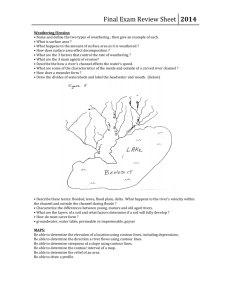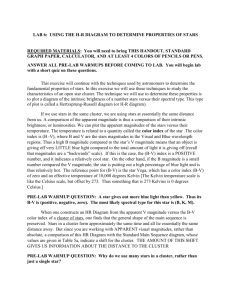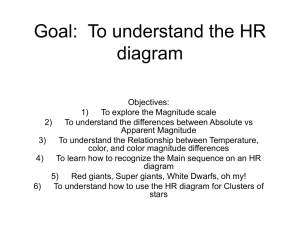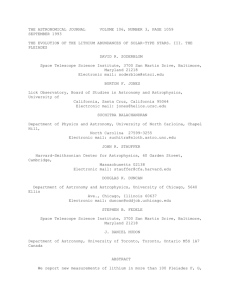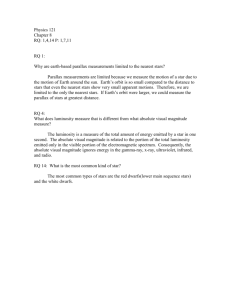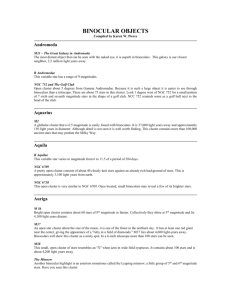Document
advertisement
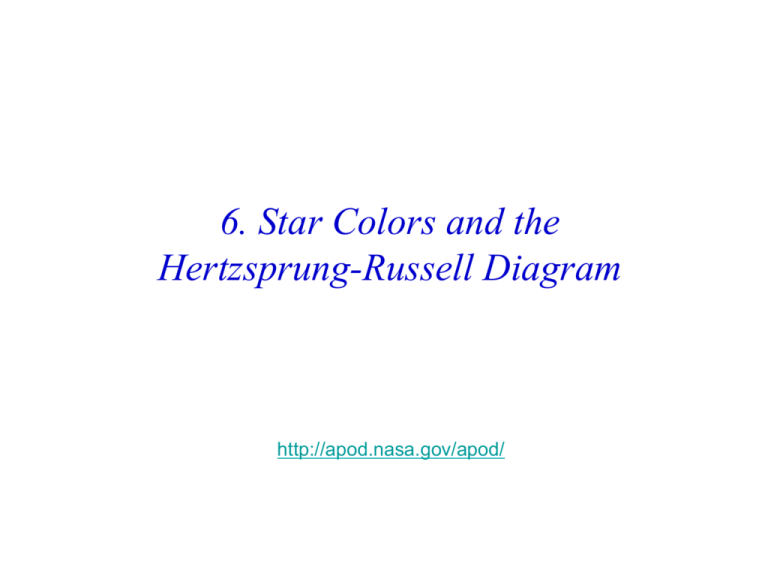
6. Star Colors and the Hertzsprung-Russell Diagram http://apod.nasa.gov/apod/ Supernovae Type Ia in M82 January 22, 2014 Still rising – may go to m = 8 (or 10?) What we can learn about stars from their light: II Color In addition to its brightness, light in general is characterized by its color. Depending on the temperature of the matter at the star s surface where the light last interacted (its photosphere ) starlight will also have a characteristic color. The hotter the star, the bluer its color. In fact, starlight is comprised of a variety of colors or wavelengths . Its perceived color is the band of wavelenths where most of the emission is concentrated. E.g., the suns yellow light can be broken up into red, orange, yellow, green and blue light by a prism or in a rainbow From Nick Strobel s Astronomy Notes FREQUENTLY USED FILTERS ON THE TELESCOPE (there are many more) o 1 A = 1 Angstrom = 10 −8 cm Astronomers historically have measured the color of a star by the difference in its brightness (magnitude) in two images, one with a blue filter (B) and another with a visual filter (V). (i.e., B = mB; V = mV) This difference, denoted (B-V), is a crude measure of the temperature. Note that the bluer the object, the smaller B will be (small magnitudes mean greater fluxes), so small or more negative (B-V) means bluer and hence hotter temperature. A SMALLER COLOR INDEX MEANS A HOTTER STAR T The sun (B-V) = 0.65 magnitudes The Hertzsprung-Russell Diagram - or HR-diagram - of a group of stars is a plot of their colors (or temperatures) vs. their bolometric absolute magnitudes (or luminosities) HR diagram for nearby stars from Hipparcos - 4477 stars, distance good to 5%. Absolute visual magnitude vs. (B-V) (color indicates star density on the plot. 1 red point = 10 stars) Sun = 0.65, 4.83 Hertzsprung–Russell diagram with 22,000 nearby stars from the Hipparcos catalog supplemented with 1000 stars from other catalogs. Absolute bolometric magnitude has been converted into luminosity, Note that the stars prefer to congregate in well defined strips Looking ahead, color can be converted to temperature and absolute magnitude to luminosity to give the Hertzsprung-Russel diagram in more physical units And in full glory … Hertzsprung-Russell Diagram for Local Stars (a volume-limited sample) More luminous Less luminous hotter cooler In many cases, the stars themselves can be used as standard candles, once the HR-diagram is calibrated. But need to know it is a main sequence star. Hyades Open cluster Constellation Taurus Magnitude 0.5 Angular size 330 Pleiades: Open cluster Constellation Taurus Magnitude 1.6 Angular size 110 Stars in each cluster were born together and are approximately equidistant Hyades Cluster Age = 800 My radius = 2.7 pc distance = 47 pc 400 solar masses HR Diagram for the Pleiades – an open cluster of about 1000 stars. No red giants or white dwarfs. Some of the more massive stars are starting to evolve away from the main sequence. Age = 65 My absolute magnitude or luminosity Open circles are Hyades; blue points are Pleiades One can also use the HR-diagram of a cluster (or even individual main sequence stars) to get distances. Because of the spread in the main sequence width, the distances are not very precise (compared, e.g., with Cepheids) but there are a lot more ordinary stars than Cepheids and some of them are very luminous. Which is older? Which is closer? By how much? Age ~ 800 million years compare at B-V = 0.4 m = 6.5 and 9 Age ~ 65 million years E.g., at B-V = 0.4 (assume MS stars with same B-V have same absolute M) Hyades m = 6.5 Pleiades m=9 m = mH – mP = -2.5 m2 – m1 = 2.5 log (1/2) let 2 = Hyades mH – mP = -2.5 =2.5 log(P/H) log(P/H) = -1.0 So P/H = 0.1 But for main sequence stars of a given B –V, L is constant, and since L φ≡ 4π d 2 the distance to the Pleiades must be farther by a factor of ~ 10, or about 3 times farther away. (Hyades 47 pc; Pleiades 140 pc) We could also just use the sun and Pleiades cluster to get a distance. For its color, the sun would have an apparent magnitude in the Pleides of 10.3 (see graph) (B-V) = 0.65 M V = 4.83 M - m = 5 - 5 log (d) 4.8 - 10.3 - 5 = 2.1 = log (d) -5 d = 126 pc or use any other star whose absolute magnitude is known An old cluster horizonal branch red giant branch main sequence If the cluster is highly evolved and most of the massive stars are gone, one can still use that portion of the main sequence that remains unburned. Age of cluster = main sequence life time of the heaviest star still on the main sequence E.g., if that mass is 1.0 solar masses the cluster’s age is the main sequence lifetime of a 1.0 solar mass star which is very nearly 10 billion years if the turn off mass is instead 0.8 solar masses 2 ⎛ 1M ⎞ τ ≈ 10 yr ⎜ = 13.8 billion years ⎟ ⎝ 0.85 M ⎠ 10 Turn off masses are our main tool for dating the ages of star clusters Other distance indicators (very uncertain) - relates L of a galaxy to its rotation rate absolute magnitude 4 L ∝ vrot rotational speed TYPE Ia SUPERNOVAE SN 1998dh SN 1998aq SN 1998bu For several weeks the luminosity of a Type Ia supernova rivals that of a large galaxy - 1043 erg s-1, or several billion solar luminosities. HST SN 1994D It is currently quite feasible to measure supernova light curves down to a magnitude m = 22. If the absolute magnitude of a typical Type Ia supernova is M = -19.5, how far away can we use them as standard candles for getting distance? M − m = 5 − 5 log (d ) −19.5 − 22 = 5 − 5 log (d ) −41.5 − 5 = − 5log (d ) −46.5 log(d ) = = 9.3 −5 109.3 = 2 ×109 pc So, two billion parsecs or about 6 billion light years Type Ia supernova in a galaxy 7 billion light years away (z = 0.5) - Garnavitch et al (1998) TYPE Ia SUPERNOVAE ARE ALMOST STANDARD CANDLES AND IT CAN BE MADE EVEN BETTER … The width of the light curve is correlated with its peak luminosity. Brighter = Broader This relation, known as the Philipp s relation exists because both the brightness and width are correlated with the amount of radioactivity (56Ni) each supernova makes (to be discussed). Using this correlation, much of the spread in the observations can be narrowed. • Eventually the expansion of the universe becomes apparent. One measures a cosmological red shift that is correlated with the distance Far Near wavelength is in units of 10-7 cm (nanometers) From Nick Strobel s Astronomy Notes The cosmolgical expansion of the universe. nb. The distance to the sun is not increasing nor are you getting any larger. R0 R Then R0 1+ z = R R ≤ R0 Now http://www.astro.ucla.edu/%7Ewright/balloon0.html repulsive nearly empty closed, crit R/Ro overdense velocity is the slope of this curve at a given time The expansion velocity is the slope of these curves at a given time If one could measure the distance to and recessional rate of very distant objects, expansion speed at different epochs in the evolution of the universe, then one might discriminate not only the age of the universe but what kind of universe we live in. What is actually measured is the redshift. The redshift is related to the age of the universe when the light was emitted, but it is actually a measure of the relative size of the universe. Define 1 ⎛ dR ⎞ H= ⎜ ⎟ R ⎝ dt ⎠ dR ⎡ ⎤ "v" ~ = H R ⎢⎣ ⎥⎦ dt Nearby R is about Ro and dR/dt is nearly constant so H is a constant Ho called the Hubble constant. One gets a linear relation between expansion speed (as measured by redshift) and distance v = Ho d if v << c, z ~ v/c http://hubblesite.org/newscenter/archive/releases/2009/08/full/ If H 0 = 71km s-1 Mpc-1 (from Cepheid Variables + Type Ia SN+WMAP) 1Mpc =3.08 x 1024 cm =3.08 x 1019 km H o = (71/ 3.08 x1019 )s-1 1/ H o = (3.08 x1019 / 71) s = 4.33 x1017 s = 13.7 billion years but this is for a universe that expanded with constant speed (i.e., contains no matter). For one that contains just enough matter to coast to infinity and stop ⎛ 2⎞ ⎜⎝ 3 ⎟⎠ (1/ H o )= 9.1 by But other measures are consistent with 12 – 14 billion years. • Globular cluster ages • Radioactive dating of the elements WMAP (2011) correct H o = 71± 2 km/ ( s Mpc ) Age = 13.75 ± 0.11 billion years http://map.gsfc.nasa.gov/universe/uni_age.html http://en.wikipedia.org/wiki/Age_of_the_universe If the expansion of the universe is now accelerating, it moved slower in the past and took longer to get to its present size than just 1/Ho would suggest. * http://en.wikipedia.org/wiki/Dark_energy More recent Planck mission results suggest 26.8% dark matter, 68.3% dark energy and 4.9% ordinary matter A major question: Is dark energy constant in space and time – a certain amout of energy per unit volume for the vacuum or does it change with time and place. Is it a cosmological constant or some sort of scalar field (quintessence)? Or do we misunderstand gravity on very large scales? Dark energy has no effect on scale of the solar system which is completely dominated by ordinary matter. Dark energy and dark matter are, for now, totally different things. The most profound mystery in modern physical science. redshifts http://en.wikibooks.org/wiki/General_Astronomy/The_Distance_Ladder
